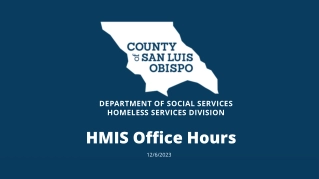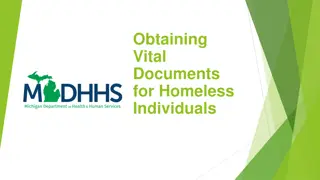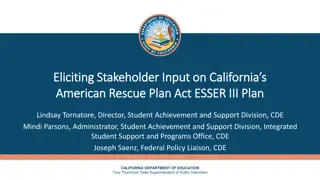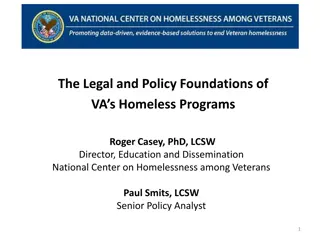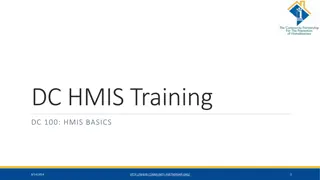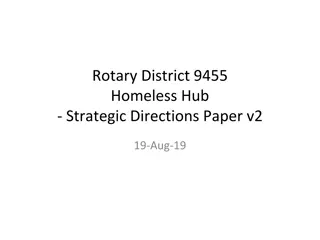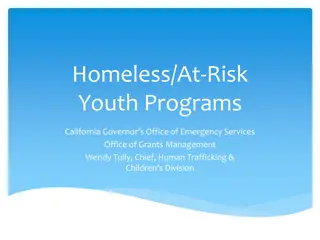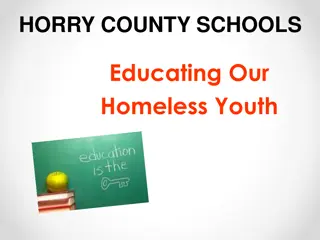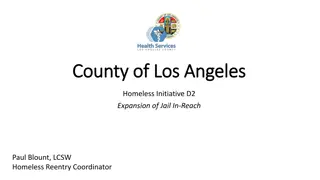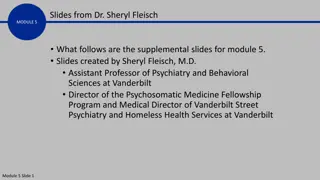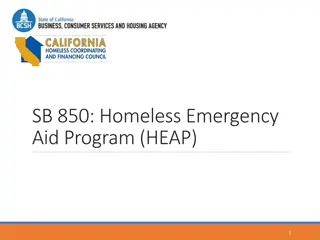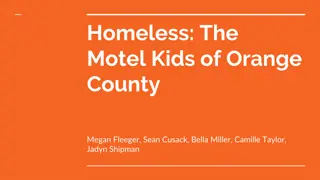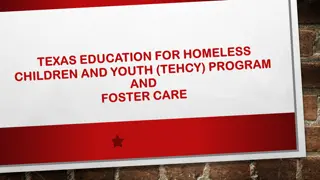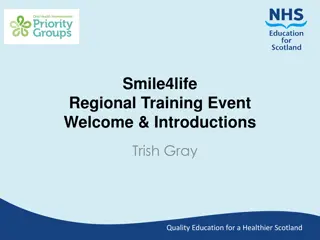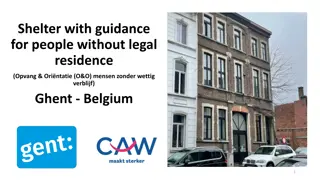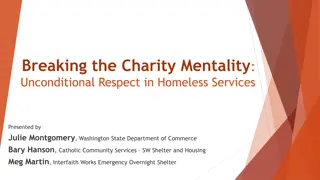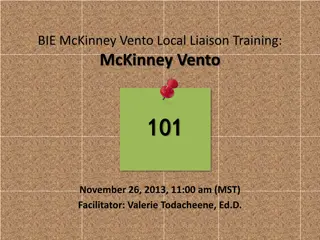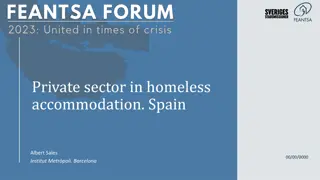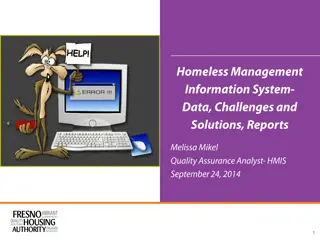Advancing Coordination of the Winnipeg Homeless Sector Community Report
The report discusses the Homelessness Partnering Strategy (HPS) in Winnipeg, focusing on funding streams, community engagement, and research methodology. It outlines key themes, recommendations, and actions taken to date, aiming to address gaps and challenges in the homeless sector for better coordination and alignment opportunities.
Download Presentation

Please find below an Image/Link to download the presentation.
The content on the website is provided AS IS for your information and personal use only. It may not be sold, licensed, or shared on other websites without obtaining consent from the author. Download presentation by click this link. If you encounter any issues during the download, it is possible that the publisher has removed the file from their server.
E N D
Presentation Transcript
Advancing Coordination of the Winnipeg Homeless Sector Community Report June 27, 2018
TODAYS AGENDA Overview of Homelessness Partnering Strategy (HPS), Community Entity (CE), and Community Advisory Board (CAB) Background to Advancing Coordination research Research Methodology Key themes emerged from the research Top 5 Recommendations Action to Date Next Steps
HPS Funding in Winnipeg * Unique community-based program aimed at preventing and reducing homelessness. * Direct funding to communities across Canada to address local needs and specific homelessness priorities. * April 2012 City of Winnipeg was recommended by CAB & approved by the Minister of HRSDC to act as CE for Winnipeg April 2012-March 2014 * March 2014 City of Winnipeg was recommended by CAB & approved by the Minister of HRSDC to renew agreement as CE for April 1 2014-March 2019
HPS Funding in Winnipeg HPS Funding Streams & Amounts *Designated Communities ~ $4.44 M/year *Aboriginal ~$4.41 M/year Current Funding Period: *April 1, 2014 to March 31, 2019, renewable
Impetus *Agreement that Winnipeg s homeless serving sector could be better coordinated. *Agreement there are opportunities to better integrate community knowledge with the HPS Community Plan. *As a result, the CE, with the support of the CAB, put out a call for proposals to assist the HPS team in conducting this research.
Purpose of the Report 1) Identify gaps, incongruities, and challenges within Winnipeg s homeless sector, and opportunities to address them 2) Support the CAB and CE in proposal review for 2017-19 3) Develop a shared understanding of alignment opportunities 4) Support CAB and CE with information and community input to make recommendations and decisions into the future.
Methodology *Discussion Groups (5 held with 40 people in total; including lived experience, frontline services, Housing First services, Indigenous-led organizations, and system- level stakeholders) *Analysis of the Community Plan to HPS Funding from an Indigenous perspective *Analysis of partner-funder priorities *System Mapping *A Best-Practices Comparison to other jurisdictions
Guiding Principle When implementing the recommendations below; intended to build a coordinated, comprehensive, and complete system of care, it must be kept in mind that Indigenous people constitute approximately three-quarters of the population experiencing homelessness in Winnipeg. Ending homelessness in Winnipeg will not happen unless the distinct needs of Indigenous people and Indigenous organizations are addressed. It bears restating, then, that the following considerations should be incorporated into the development of any plans to address the recommendations presented in this report and, more generally, into future funding-related decision-making.
Distinctiveness of Indigenous Homelessness Culture is - and should be - part of everything. Culturally appropriate services and cultural safety Root causes of Indigenous peoples overrepresentation in homeless population linked to historical and present-day experiences Intergenerational impacts include trauma, addictions and other complex needs We must ask: Do funding allocations to Indigenous organizations reflect the scope, scale, and nature of the work being done?
Overarching Themes The Distinct Needs of Indigenous Peoples Governance, Planning, and Coordination Policy, Administration, and Funding Programs and System Development Fostering Collaboration and Capacity Building Clarifying Communications
Top 5 Recommendations 1. Develop a Planning and Coordination Table 2. CE to reduce the competition inherent in the CFP process 3. CAB / CE / Service Canada to prepare for 2019 funding cycle end 4. CE to continue efforts to reduce financial reporting requirements 5. Improve communication and information sharing
Recommendation 1 - Develop a Planning and Coordination Table Recommendations: * System Level stakeholders should meet to develop a strategy for planning and coordination * Establish a single Planning and Coordination Table (suggested Mandate and Activities in the report) * Move forward with the proposed common funder s table * Create a community of practice among direct service workers * Confirm and stabilize a long-term CE
Recommendation 1 - Develop a Planning and Coordination Table Recommendations cont d: * CAB to communicate its role as a provider of expertise to the CE, NOT as a representative of the community. * Hire an Indigenous liaison within the Community Entity that works on developing and expanding the portfolio * Terms of Reference, meeting minutes, plans, research-reports, and activity reports of CAB and CE to be publically posted, preferably on a website * Long-term: as a whole community develop a governance structure that facilitates a coordinated, comprehensive, complete system of care.
Action to date * System level planning with stakeholders has begun and is being lead by End Homelessness Winnipeg (EHW) (Community Services Sector Leadership Council) in which the CE and CAB are involved. * Funders table has been established by EHW and includes the CE. * Housing First Sector Leadership Committee has been established. * Website page has been created on Winnipeg.ca CAB s ToR, plans, research reports, activity reports, funded HPS organizations
Action to Date contd * Indigenous Liaison within the CE continues working directly with Indigenous providers * Mandatory Indigenous training implemented by the CE (All staff completed) * CAB Alignment Committee based on Strategic planning Nigel/Christina * Rent supplement program has not been implemented in Winnipeg Province of Manitoba is working on implementation
Long Term Goals *Long-term: as a whole community develop a governance structure that facilitates a coordinated, comprehensive, complete system of care. (Leadership Council) *CAB Terms of Reference is posted on Winnipeg s HPS web site. Further review of Term of Reference to occur that will clearly communicate its role as a provider of expertise to the CE, NOT as a representative of the community.
Leadership Council Multi-agency Committees Supporting Homelessness Sector - System Level Community Service Sector Leadership Council CAB Sector Level Committees Youth homelessness strategy governance Youth Gender based Strategy Long Term Plan to End Homelessness Homelessness Strategy Housing Supply Housing with Supports Prevention Emergency Resources Measurement Housing First Focus Committees Alliance Extreme Weather Strategy Shelters Committees Shelter HIFIS Governance HIFIS Governance Street Health Survey Committees Housing Model Development Working Group Committees Reintegration and Homelessness Prevention Eviction Prevention Doorways Steering Committee HF Service Level Committees Other Housing Support Committees Homeless Outreach Mentor Team Mtgs MAPS Project Breakaway Steering Cmt Housing First Sector Leadership Committee Replaces HF Collective, HPS Doorways Cmt, & Housing with Supports WG (see reverse for responsibility) Doorways Placement Cmt Complex Situations Cmt MGR Task Group HF Monthly Meetings (WRN) HOCS Community Coordinating Network HOCS Consultation Meetings
Housing First Leadership 1 Expanded View of Housing First Sector Committees/Roles Housing First Focus Doorways Steering Committee HF Service Level Committees Housing First Sector Leadership Committee Replaces HF Collective, HPS Doorways Cmt, & Housing with Supports WG Focus areas: Fidelity assessment framework/standards Training framework Collective Impact Reporting/Data Leadership to support Doorways Identification/ resolution of system issues affecting HF HF resource planning and recommendations (Shared funder leadership. Replaces existing single funder facilitated mtgs with HF groups.) Doorways Placement Cmt Complex Situations Cmt MGR Task Group HF Monthly Meetings (WRN) HOCS Community Coordinating Network HOCS Consultation Meetings
Recommendation 2 CE to Reduce Competition inherent in CFP Process Recommendations: *Funding to Indigenous organizations should reflect the scope and scale of the work being done. Funding should be flexible. *CE should increase the value placed on partnerships as should CAB s assessments. *CE should publish the selection criteria for proposals online. *CE should undertake analysis of proposals and submit to CAB.
Recommendation 2 CE to Reduce Competition inherent in CFP Process Recommendations cont d: *CE should develop an open and fair process to develop weaker proposals. *CAB and CE should consider inequities when expecting matching funding. *CE should target gaps in the system with CFPs. *Medium Term: CE to develop a new process to fund programs that reduces competition.
Action to date *CE/CAB has targeted GAPs within the system Last two CFP (e.g. Transitional Housing - creation of 27 units) *More value was placed on partnerships and clearer definitions were provided regarding partnerships. *Selection criteria is outlined within the CFP documents and will be made available on our website during any CFP.
Action to date contd *Shared system indicators have been established by HF leadership team. *Indigenous sector engagement of Indigenous consultant (Celeste McKay) to provide technical support to the sector *Ongoing review and improvement to ensure user-friendly application
Long Term Goals *CE to develop a new process to fund programs that will reduce competition. *Fidelity review for all HF organizations have been completed work has begun for creating local Fidelity standards. *CAB sub committee proposal review committee
Recommendation 3: Confirm and Stabilize CE for 2019 and beyond RECOMMENDATION: CAB, CE & Service Canada prepare for 2019 funding cycle end, confirm and stabilize long-term CE. ACTION TO DATE: * What we Heard doc published *June 11, 2018 Annoucement on the redesigned Homelessness Program Reaching Home Program *Further details to follow Fall 2018 WORKING ON: *Confirm and stabilize a long-term CE
Recommendation 4: CE to Continue efforts to Reduce Reporting Requirements Recommendations: *CE to continue to expand efforts in reducing and/or improving reporting requirements. *CE and Service Canada should be clear in its communication on how outcome reporting is used nationally and it s importance.
Recommendation 4: CE Continued efforts to Reduce Reporting Requirements Recommendations cont d: *CE should continue to inform proponents of their options on reporting *CE should support agencies struggling with outcome reporting by providing them with administrative expertise, and supports *CE to provide better information about financial reporting requirements upfront during the CFP process *The Planning and Coordination Table along with the Funders Table should decide on the outcome priorities and benchmarks that are most important to all stakeholders *Long Term Goals: All stakeholders develop shared system indicators
Action to date *CE is in the process of completing its Policy and Procedures Manual and it will be shared with all HPS funding programs. *CE held two information sessions: *CFP Information Session July 26, 2017: 19 in attendance; 5 representing Indigenous organizations & 9 Designated organizations *CFP Information Session August 15, 2017: 16 in attendance; 3 representing Indigenous organizations and 8 Designated organizations
Action to date *CE continues to work with all proponents to ensure flexibility is possible in program delivery models *CE posts annual Community Planning updates on it s website including annual results *CE has been working with organizations to demonstrate the importance of indicator reporting and has put in place tools to assist organizations *Simplified application was implemented during the last CFP process
RECOMMENDATION 5: Improve Communtication & Information Sharing Recommendations: *Widely and clearly communicate the meanings of Alignment, Collaboration, Centralization, and Coordination so discussion can begin *Clearly define the roles of the principle system stakeholders *Continue to inform service provider organizations about HPS funding and its funded activities *Continue to inform service provider organizations about budgeting projects and flexibility for un-anticipated costs
RECOMMENDATION 5: Improve Communtication & Information Sharing *CE to hold information sessions on accessing HPS program funding *CE continue to inform service provider organizations about activities-performed and the resultant indicators that must be reported upon *Continue to inform service provider organizations about policies on re-allocating budgets
RECOMMENDATION 5: Improve Communtication & Information Sharing *Clarify how HPS funded programs can access services provided by Housing Plus. *Clarify with service programs that when finding an apartment outside of the Housing Plus procurement process, they let Housing Plus know so they can put their procedures in place. *Clarify that units found outside of central procurement, must meet the standards of the Province to ensure that they are eligible for rent supplements
Actions to date *Ongoing discussion with HPS organizations on a monthly basis regarding slippage within budgets and flexibility in activity changes *Quarterly meeting with HF organizations ongoing work towards standardized process *Orientations for new or existing HF organizations (e.g. Doorways process and WRN process)
Actions to date *Creation of HPS webpage on Winnipeg.ca *CE held two information sessions *CFP Information Session July 26, 2017: 19 in attendance; 5 representing Indigenous organizations and 9 Designated organizations *CFP Information Session August 15, 2017: 16 in attendance; 5 representing Indigenous organizations and 8 Designated organizations
Reported Outcomes for City of Winnipeg Administered HPS Program * Housing First Outcomes April 1, 2016 March 31, 2018 293 participants housed 141 participants began receiving Emergency Housing Funds 118 participants began receiving EIA 22 participants began employment 60 participants began an education program or employment skill training 191 participants experienced positive changes in social participation 90 participants engaged in volunteer work 141 participants engaged in recreational or cultural programs or services 28 Successful exits from Housing First programs 54 Returned to homelessness
Reported Outcomes for City of Winnipeg Administered HPS Program Report Results cont d: *HPS Program: Non- Housing First Outcomes 1168 participants moved to more stable housing 246 participants began employment 289 participants began an education program 27 Transitional Housing units created
NEXT STEPS/KEY PRIORITIES *PIT action items More info to come after report is released in Fall 2018 *Sector Leadership Council *Housing First Leadership Committee *HPS changes post 2019 Information sessions to occur in Fall 2018
NEXT STEPS/KEY PRIORITIES *CAB Call for Participation Fall 2018 *CE Contract expiry March 31, 2019 TBD *Next Community report on actions to date to improve coordination Spring 2019 *New HPS Community Plan will be developed for 2019 Stay tuned
Advancing Coordination of the Winnipeg Homeless Sector
















